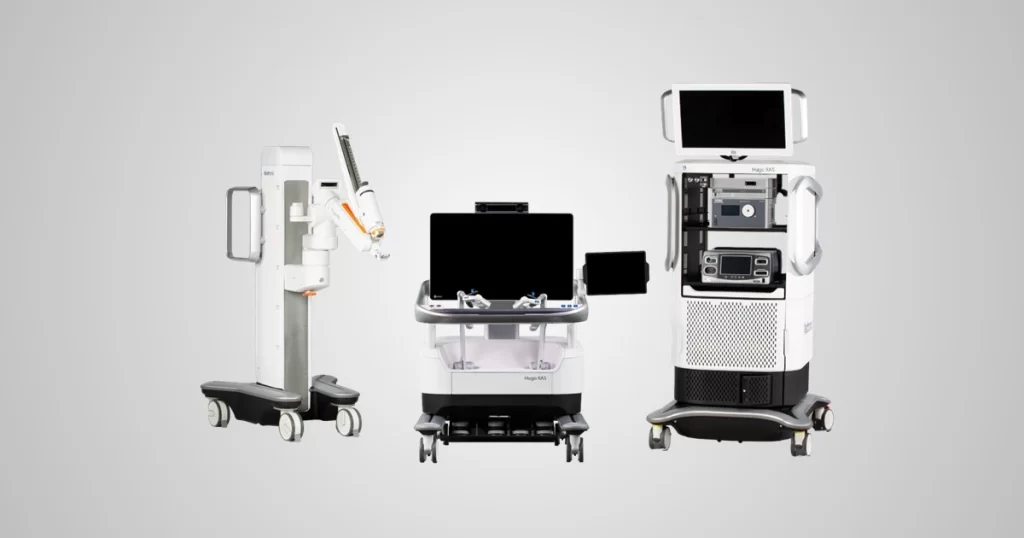In the landscape of modern medicine, robotic-assisted surgeries have emerged as an innovative and highly effective approach to performing complex surgical procedures. These surgical methods provide significant benefits in enhancing surgical precision, reducing operative complications, and expediting patient recovery times.
The Rise of Robotic-Assisted Surgeries
In the last decade, the field of medical robotics has experienced a dramatic expansion. This rapid growth is primarily driven by the benefits robotic-assisted surgeries bring to the medical field, including increased surgical precision, decreased invasiveness, and shorter recovery times.
Robotic Assistance in Surgical Precision
One of the most significant advantages of robotic-assisted surgeries is the remarkable improvement in surgical precision they provide. The computer-enhanced technology gives surgeons superior control over surgical instruments and a better view of the surgical site compared to traditional methods.
Robots can reduce the likelihood of human error by eliminating physiological tremors, allowing surgeons to perform delicate procedures, such as heart and neurosurgeries, with greater precision. They can make smaller and more accurate incisions, which leads to less blood loss and reduces the risk of infection.
Enhanced Recovery Times with Robotic Surgery
Robotic-assisted surgeries also drastically improve patient recovery times. Due to smaller incisions and less invasive procedures, patients typically experience less pain, minimal scarring, and a quicker return to daily activities.
A study published in the Journal of Robotic Surgery showed that patients who underwent robotic surgery for prostate cancer had a 24% reduction in hospital stay compared to those who had open surgery.
The constant evolution of robotic surgery advancements has been pivotal in its increasing adoption. Today’s surgical robots can provide real-time imaging, enabling surgeons to navigate through complex anatomical structures effectively.
Moreover, the latest advancements include haptic feedback, machine learning algorithms for improved surgical planning, and the use of artificial intelligence to assist in intricate procedures.
Traditional vs. Robotic-Assisted Surgical Methods
Comparing traditional and robotic-assisted surgical methods, it is clear that the latter provides distinct benefits. The minimally invasive nature of robotic surgery reduces the trauma to the patient, reduces the risk of infection, and leads to faster recovery times.
On the other hand, traditional open surgery requires larger incisions, leading to increased post-operative pain, longer hospital stays, and a slower return to normal activities.
However, it is essential to understand that robotic surgery is not a replacement for the surgeon. Instead, it enhances their capabilities and allows for greater precision and flexibility during the operation.
Types of Robotic-Assisted Surgeries
Robotic-assisted surgeries have revolutionized the medical field, offering increased precision and control, minimal invasiveness, and enhanced patient recovery times. Various types of these surgeries are now routinely performed across diverse medical specialities. Here, we delve into some of the primary areas where robotic-assisted surgery has made significant strides.
Robotic-Assisted Cardiothoracic Surgery
Cardiothoracic surgery involves procedures on the heart, lungs, and other structures within the thoracic cavity. Robotic-assisted techniques have enabled surgeons to perform complex procedures such as coronary artery bypass grafting, mitral valve repair, and lung cancer resections with exceptional precision. These minimally invasive procedures result in less blood loss, reduced pain, and faster recovery times compared to traditional open surgeries.
Robotic-Assisted Urologic Surgery
Robotic-assisted surgeries have significantly impacted urology, with procedures such as prostatectomies, nephrectomies, and bladder surgeries now commonly performed using this approach. The da Vinci Surgical System, one of the most widely used robotic systems, has been particularly beneficial in treating prostate cancer, enhancing surgical precision while preserving crucial nerve structures.
Robotic-Assisted Gynecologic Surgery
In gynecology, robotic-assisted surgeries offer significant advantages for procedures like hysterectomies, myomectomies, and sacrocolpopexies. The increased precision and control provided by the robotic systems can lead to less scarring, reduced post-operative pain, and faster recovery times.
Robotic-Assisted Gastrointestinal Surgery
Robotic-assisted surgical systems are utilized in a range of gastrointestinal surgeries, including colectomies, gastrectomies, and esophagectomies. These minimally invasive procedures result in less tissue trauma and shorter hospital stays, while providing surgeons with a high-definition, 3D view of the complex anatomy of the gastrointestinal tract.
Robotic-Assisted Head and Neck Surgery
Head and neck surgeries present unique challenges due to the presence of critical anatomical structures in a confined space. Robotic systems, with their advanced optics and precise instrumentation, are increasingly being used in transoral surgeries, thyroid surgeries, and base-of-skull surgeries.
Components of Robotic-Assisted Surgeries
Robotic-assisted surgery involves the use of advanced surgical systems to aid surgeons in performing complex surgical procedures with greater precision and control. Here are some key components that make up a typical robotic-assisted surgical system:
Surgeon Console: The surgeon console is the control center for the surgeon. From here, the surgeon operates the robot’s arms and instruments while observing the surgical field in 3D, high-definition vision. This console provides the surgeon with magnified, clear, and precise visuals of the surgical site, offering greater control during the procedure.
Patient-side Cart: The patient-side cart is where the robot interfaces with the patient. It is equipped with multiple robotic arms that carry out the surgeon’s commands from the console. The arms can hold and maneuver various surgical instruments that mimic the movements of the surgeon’s hands, wrists, and fingers, but with a higher degree of precision.
EndoWrist Instruments: These are the specialized instruments used in robotic-assisted surgeries. They have a greater range of motion than the human wrist, allowing for a more flexible operation. These instruments can rotate 360 degrees, which is not possible with the human hand.
3D Vision System: The 3D vision system provides a magnified, three-dimensional view of the surgical site. This feature significantly improves the surgeon’s visual field, aiding in identifying complex structures and making precise movements during the surgery. The system also filters out any tremors from the surgeon’s hand, providing a steady view of the surgical field.
Robotic Platform: The robotic platform is essentially the operating system of the robotic surgical unit. It integrates and coordinates the functions of the various components, such as the console, patient-side cart, and vision system. The platform translates the surgeon’s movements at the console into micro-movements of the instruments at the patient-side cart.
Trocar: A trocar is a medical device that is used as a portal for the placement of other instruments, like the EndoWrist instruments used in robotic-assisted surgeries. The trocar is inserted into the patient through a small incision to provide access for the robotic surgical instruments.
Electrosurgical and Ultrasonic Devices: Many robotic-assisted surgical systems also include electrosurgical and ultrasonic devices for cutting, coagulating, and suturing tissues. They are designed to work seamlessly with the robotic system to ensure efficient and precise surgical interventions.
Software Algorithms: Although not a physical component, the software algorithms of the robotic surgical system play a critical role in the successful operation of the robot. The algorithms control the movements of the robot, provide safety features like movement scaling and tremor reduction, and facilitate the real-time transmission and processing of surgical data.
These components work together in a well-coordinated manner, allowing for effective and efficient robotic-assisted surgeries that enhance surgical precision and improve patient recovery times. However, it’s essential to remember that the skill and experience of the surgeon are critical factors in the success of the surgery.
Leading Companies in Robotic-Assisted Surgery
The domain of robotic-assisted surgery is dominated by a few significant players who have made substantial strides in technological advancements and commercialization.
Intuitive Surgical
Intuitive Surgical is the pioneer in the field of robotic-assisted surgery. The company’s da Vinci Surgical System, approved by the FDA in 2000, revolutionized minimally invasive surgery. This versatile system is used across a range of surgical specialities, including urology, gynecology, and cardiothoracic surgery. In 2022, Intuitive Surgical reported revenue of $6,222 million, demonstrating the growing demand for their technology. A case study by Intuitive Surgical revealed that their da Vinci system reduced hospital stays by 24% and lowered readmission rates by 20% for radical prostatectomy patients at NYU Langone Medical Center.
Medtronic
Medtronic is another key player in the field of robotic-assisted surgery. Their Mazor Robotics platform, primarily used in spine and brain procedures, has shown strong growth since its acquisition in 2018. More recently, they announced the launch of their Hugo Robotic-Assisted Surgery (RAS) system, marking their foray into soft tissue surgery. The company reported revenues of $7.4 billion for Q1 2023.
Stryker Corporation
Stryker Corporation’s Mako Robotic-Arm Assisted Technology has transformed orthopedic surgery. According to a case study, the use of the Mako system in total knee arthroplasty at the Florida Orthopaedic Institute resulted in a 36% reduction in post-operative pain and a 66% decrease in the use of opiate pain relievers. The company reported Q1 2023 sales of $4.8 billion, up by 11.8%.
Zimmer Biomet
Zimmer Biomet’s ROSA Robotic Surgical Assistant is gaining traction in the field of orthopedic surgery. The company recently announced the completion of the first surgery using the ROSA Knee System in Japan. Zimmer Biomet reported net sales of $1.831 billion for Q1 2023.
Smith & Nephew
Smith & Nephew’s NAVIO™ Surgical System and CORI™ Surgical System provide robotics-assistance in orthopedic surgeries. The company recently announced the completion of the world’s first total knee replacements using the handheld robotics-assisted CORI Surgical System in Belgium and Italy. Smith & Nephew reported Q1 2023 revenue of $1,356 million, an increase of 3.8% compared to the same period in the previous year.
Conclusion
The landscape of surgical interventions is experiencing a dramatic transformation, with robotic-assisted surgeries carving out a significant niche. The advancement and acceptance of robotic assistance have provided surgeons with unprecedented precision, leading to shorter recovery times, reduced pain and discomfort, and fewer complications post-surgery. With robust growth rates projected in various specialties from cardiothoracic to gastrointestinal surgery, robotic surgery shows a promising trajectory.
The field is witnessing considerable competition. Each company, through their technological advancements and financial growth, is contributing to the expansion of the market. Significant investments in research and development, along with positive patient outcomes, underscore the transformative potential of robotic-assisted surgeries. The future is certainly poised for even greater leaps in this exciting confluence of healthcare and technology.

